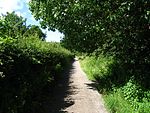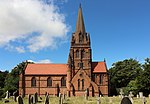Thurstaston railway station
1886 establishments in England1954 disestablishments in EnglandDisused railway stations in the Metropolitan Borough of WirralFormer Birkenhead Railway stationsPages with no open date in Infobox station ... and 3 more
Railway stations in Great Britain closed in 1954Railway stations in Great Britain opened in 1886Use British English from September 2017

Thurstaston railway station was a station on the single track Hooton to West Kirby branch of the Birkenhead Railway, on the Wirral Peninsula, England. The station served the village of Thurstaston situated to the north east.
Excerpt from the Wikipedia article Thurstaston railway station (License: CC BY-SA 3.0, Authors, Images).Thurstaston railway station
Wirral Way, Wirral
Geographical coordinates (GPS) Address Nearby Places Show on map
Geographical coordinates (GPS)
| Latitude | Longitude |
|---|---|
| N 53.3427 ° | E -3.1452 ° |
Address
Wirral Way
Wirral Way
CH48 1QX Wirral
England, United Kingdom
Open on Google Maps






